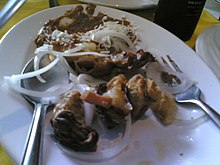
A taco is a traditional Mexican dish consisting of a small hand-sized corn or wheat tortilla topped with a filling. The tortilla is then folded around the filling and eaten by hand. A taco can be made with a variety of fillings, including beef, pork, chicken, seafood, beans, vegetables, and cheese, allowing for great versatility and variety. They are often garnished with various condiments, such as salsa, guacamole, or sour cream, and vegetables, such as lettuce, onion, tomatoes, and chiles. Tacos are a common form of antojitos, or Mexican street food, which have spread around the world.
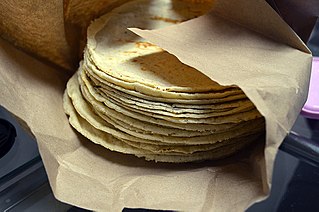
In North America, a corn tortilla or just tortilla is a type of thin, unleavened flatbread, made from hominy, that is the whole kernels of maize treated with alkali to improve their nutrition in a process called nixtamalization. A simple dough made of ground, dried hominy, salt and water is then formed into flat discs and cooked on a very hot surface, generally an iron griddle called a comal.

Tripe is a type of edible lining from the stomachs of various farm animals. Most tripe is from cattle, pigs and sheep.

A blood sausage is a sausage filled with blood that is cooked or dried and mixed with a filler until it is thick enough to solidify when cooled. Most commonly, the blood of pigs, sheep, lamb, cow, or goose is used.

Peking duck is a dish from Beijing (Peking) that has been prepared since the Imperial era. The meat is characterized by its thin, crisp skin, with authentic versions of the dish serving mostly the skin and little meat, sliced in front of the diners by the cook. Ducks bred specially for the dish are slaughtered after 65 days and seasoned before being roasted in a closed or hung oven. The meat is often eaten with spring onion, cucumber and sweet bean sauce with pancakes rolled around the fillings. Sometimes pickled radish is also inside. Crispy aromatic duck is a similar dish to Peking duck and is popular in the United Kingdom.

Offal, also called variety meats, pluck or organ meats, is the organs of a butchered animal. The word does not refer to a particular list of edible organs, which varies by culture and region, but usually excludes muscle. Offal may also refer to the by-products of milled grains, such as corn or wheat.
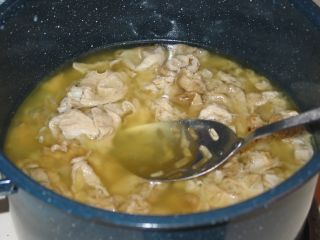
Chitterlings are a culinary dish usually made from the large intestines of a hog, although the intestines of cattle and other animals are sometimes used.

Chicharrón is a dish generally consisting of fried pork belly or fried pork rinds. Chicharrón may also be made from chicken, mutton or beef.

A gordita in Mexican cuisine is a dish made with masa and stuffed with cheese, meat, or other fillings. It is similar to the Colombian and Venezuelan arepa. Gordita means "chubby" in Spanish. There are two main variations of this dish, one which is typically fried in a deep wok-shaped comal, consumed mostly in central and southern Mexico, and another one baked on a regular comal. The most common and representative variation of this dish is the "gordita de chicharrón", filled with chicharron which is widely consumed throughout Mexico. Gorditas are often eaten as a lunch dish and accompanied by several types of sauce.

In cooking and gastronomy, duck or duckling is the meat of several species of bird in the family Anatidae, found in both fresh and salt water. Duck is eaten in many cuisines around the world. It is a high-fat, high-protein meat rich in iron. Duckling nominally comes from a juvenile animal, but may be simply a menu name.

Adovada, is a preparation of pork. Adovada is generally pork marinated in red chile.

Beef tongue is a cut of beef made of the tongue of a cow. It can be boiled, pickled, roasted or braised in sauce. It is found in many national cuisines, and is used for taco fillings in Mexico and for open-faced sandwiches in the United States. In France and Belgium it is served with Madeira sauce, while chrain is the preferred accompaniment in Ashkenazi and Eastern European cuisines. Germans make white roux with vinegar and capers, or horseradish cream, which is also popular in Polish cuisine.

Gopchang can refer to the small intestines of cattle or to a gui made of the small intestines. The latter is also called gopchang-gui. The tube-shaped offal is chewy with rich elastic fibers. In Korean cuisine, it is stewed in a hot pot, grilled over a barbecue (gopchang-gui), boiled in soup with other intestines (naejang-tang), or made into a sausage (sundae).

Chinchulín is beef small intestine, which may be grilled or fried. It is consumed in many Latin American countries.

Cocido or cozido is a traditional stew eaten as a main dish in Spain, Portugal, Brazil and other Hispanophone and Lusophone countries.
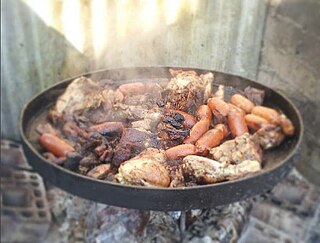
Discada is a mixed meat dish popular in the northern Mexican cuisine. The dish includes a mixture of grilled meats cooked on an agricultural plow disk harrow, hence its name. The basic meats for a traditional discada include beef, bacon, ham, sausage, and Mexican chorizo. The disk is placed over an open flame, and the ingredients are introduced one at a time. The meats are seasoned and marinated according to the cook's preference and usually include salt, pepper, lime juice, and garlic. Aromatics including white or purple onions, bell peppers, Jalapeno or Serrano peppers, olives, and tomatoes are also used to add flavor and color to the dish. It is usually served with tortillas in tacos or separately on a plate.

Dobrada or dobradinha is a traditional Portuguese and Brazilian dish made from a cow's flat white stomach lining commonly flavoured with paprika, tomato paste, onion, garlic, clove and red pepper paste. Usually decorated with green onion and mint. The adding of sliced carrots and butter beans are essential as well. White rice is often served alongside this dish, especially in the city of Porto where it is called tripas à moda do Porto.
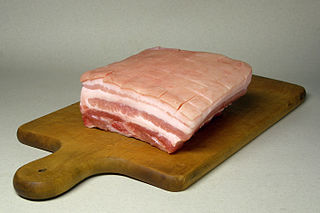
Pork rind is the culinary term for the skin of a pig. It can be used in many different ways.

Tripas à moda do Porto or dobrada à moda do Porto in Portuguese cuisine is beef stomach, and in the form of tripas à moda do Porto is considered the traditional dish of the city of Porto.
